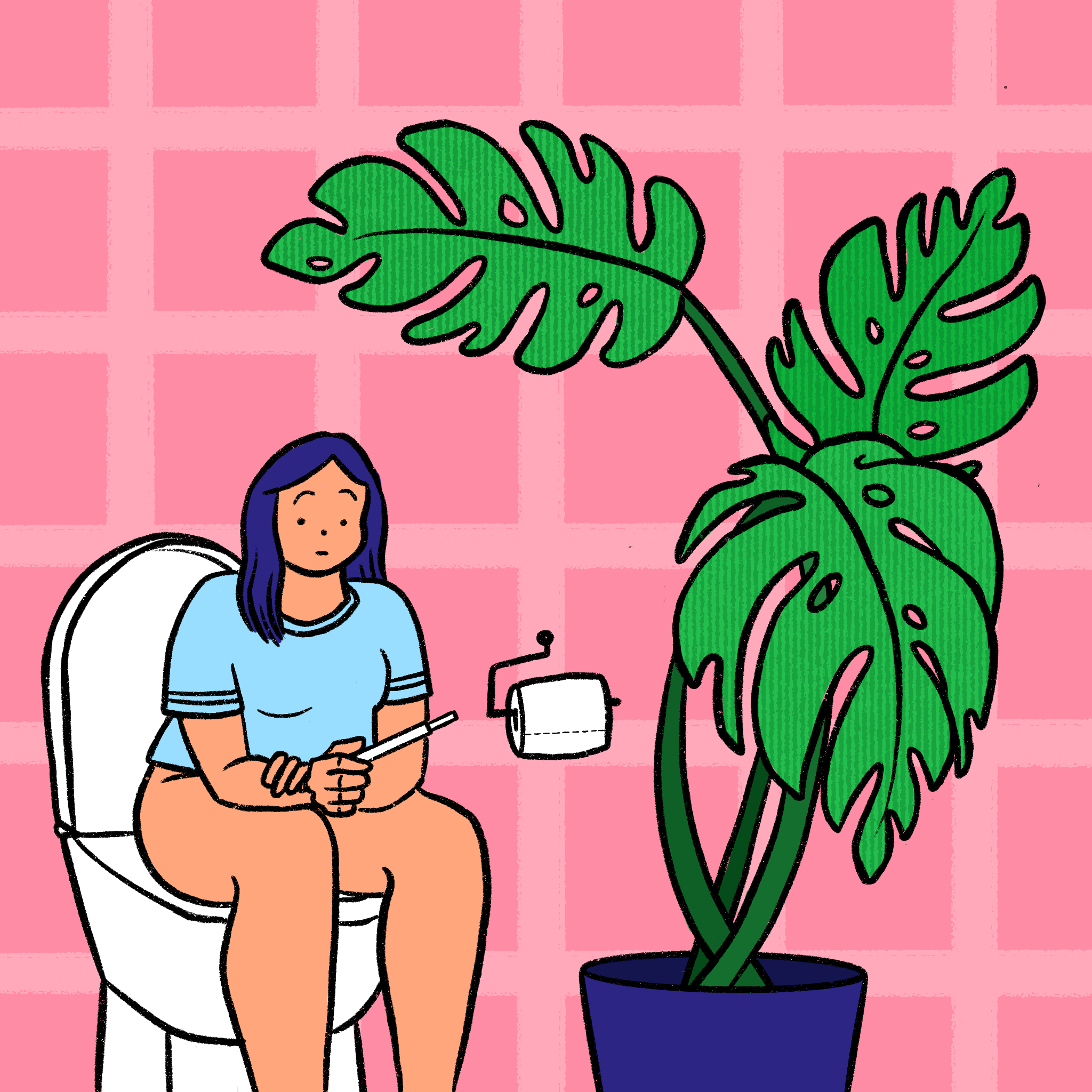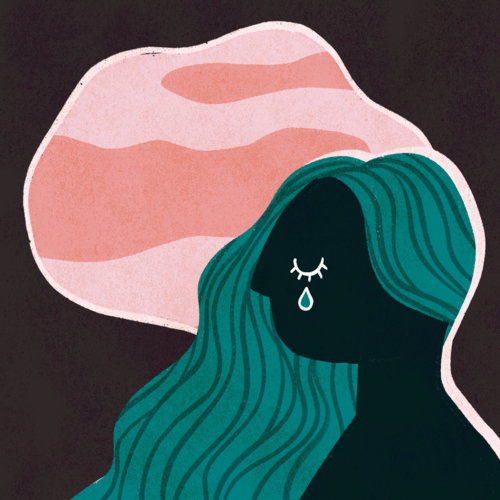Not Superstitious—Just OCD
A life-changing diagnosis sheds light on the past.
Illustrated by Ally Hart
There’s a crack, a line, a chasm, if you will, between being superstitious and believing fervently that your compulsions will save your life.
If you’re diagnosed with obsessive-compulsive disorder (OCD) like me, that line begins to blur. My experiences have shaped me in a way only OCD can, but after years of tiptoeing around triggers and throwing salt over my shoulder, I am finally at a point where I can look back and bring that blurry line into focus. But whatever you do, do not step on that crack lest you break your mother’s back.
Obsessive-compulsive disorder is characterized by uncontrollable, recurring thoughts (obsessions) and behaviors (compulsions) that one feels the urge to repeat. While many people self-diagnose themselves with this disorder, on account of their ritualistic behaviors or seemingly obsessive need to clean, only 2.3% (1 in 40) of U.S. adults are actually diagnosed with lifetime prevalence of this disorder. Obsessive-compulsive disorder tends to be all-consuming; among adults diagnosed, 50.6% have serious impairment as a result of the illness. It is a long-lasting disorder with no known cure, but there are treatments that may help abate its effects.
Beyond these numbers, there are real people moving through the world with OCD, myself included. From the age of four, I spent most nights laying in bed staring at the uneven pink lines of my wallpaper. The quirky curve of the line was supposed to be playful and hundreds of little girls across America probably adored it, but it haunted me. They were not all identical. On top of that, my fear that the house would burn down, that my father would not return home after his late shift, or that someone was going to break in and murder me kept me on alert. I used to demand that my mother sign in to my journal each time she checked on me during the night to ensure I was safe for the few hours I let my guard down to rest. My parents didn’t mind much at the time, watering down my obsessions to weird little quirks. My mother catered to my anxieties, even installing self-closing cabinets when we remodeled our home to soothe the itching angst I got when drawers were left ajar. After I was finally officially diagnosed in 2016, my mother worried that perhaps she had propagated my obsessions and compulsions in those early days. But that was just the way my brain was wired; there was nothing she could do or not do to change that. My childhood all-nighters were proof of that.
“The quirky curve of the line was supposed to be playful and hundreds of little girls across America probably adored it, but it haunted me. They were not all identical.”
As a byproduct of those sleepless nights, I began fantasizing incessantly. I pictured what I wanted my life to look like at 13, 16, 18, 21, 30, each year with a distinctive bookmark — a first boyfriend, high school, a new car, college, a wedding. But these weren’t passive, playful daydreams. These were detailed and heavily researched. I grew anxious when I couldn’t picture the explicit beading of the dress I was to be married in or which kind of friend I wanted to spend my lunch periods avoiding eating with in high school. I swore to myself these fantasies would become real, exactly as I had imagined them, and therefore if I had a shitty life, I would have no one to blame but my incompetent 8-year-old self.
I would learn later that this is called manifestation. A viral trend nowadays, manifestation is the idea that you can bring something into being just by thinking, feeling, or believing it. It’s touted as a miracle salve by “experts” and celebrities including Oprah, Will Smith, and Lady Gaga as the cure-all to mastering your life and achieving everything you have ever dreamed of, down to the brand of sock your new fiancé wears (well, once you manifest a fiancé, that is). I’ve been attempting to manifest moments, people, and places into my life since I was a child, way before it was chic. The glamorized versions of manifestation I see being sold today are nothing like my childhood obsessions.
By the time I got to college, I began to grow out of my manifestation phase. I came to the grim realization that life doesn’t always turn out how you imagined it would, no matter how tightly you squeeze your eyes shut or make a wish at 11:11. So, I concluded that I must be jinxing the good things. I was imagining them too ardently and therefore, what I had dreamed up could never occur. I became obsessed with the concept that if I thought about what I wanted, the world would spite me and not deliver. So I disassociated from my cherished manifestation pastime and tiptoed strategically around my deepest desires.
“The glamorized versions of manifestation I see being sold today are nothing like my childhood obsessions.”
Around that same time, my OCD ramped up (whether this was a coincidence or not is a futile debate which I will save for my therapist). I started to connect my compulsions with the idea of jinxing. I now harbor a profound dread of the number “3” and doing anything in threes. Writing that sentence made me uncomfortable. If I text him back with three words he won’t respond. If I eat three slices of pizza, I’ll choke on the third and die. Any word written in this article with three letters has been deleted and re-written a second time so that it “technically” is six letters long. Otherwise, a three-letter word may prevent this piece from getting published.
I am positive of these things. I believe in them the way I believe in God, an otherworldly, perpetually looming presence that I have no authority over. I learned to tend to my compulsions like little weeds, warping my daily habits and social interactions, to avoid jinxing things. I can’t listen to this song, or wear that shirt, or eat a piece of food because doing so would jinx myself. If I don’t comply, I feel nauseous and sometimes throw up. My brain works overtime in an effort to meet my tendencies, my OCD growing uglier by the day. I was late to work because I had to place things to face specific directions in my room. I was leaving half of my food uneaten because I couldn’t eat what my friends lovingly refer to as “the bad pieces,” which they happily ate without an issue. Everything became tied up in rituals in a desperate attempt to gain control of my life, but instead, the OCD began controlling me.
But about a year ago, I realized I had to do something to help myself, to prevent my OCD from completely taking over. I first sought help from my therapist. She told me that since OCD hardly ever fully goes away and even medication isn’t likely to be effective, exposure therapy was the only way my condition could get better. I felt sick at the idea of confronting my fears and forcibly doing the things I have avoided for years, but she hadn’t led me astray before.
“I can’t listen to this song, or wear that shirt, or eat a piece of food because doing so would jinx myself. If I don’t comply, I feel nauseous and sometimes throw up.”
We created a log and decided to attack my morning ritual first. I was supposed to leave my room in the morning without altering any object’s position, flickering the lights four times, checking each candle, or closing the door a dozen times. The task would seem simple to anyone else; when you’re ready for work, you simply leave and close the door behind you. However, on my first attempt I made it halfway down the stairs until I froze, felt sick, and ran back up to give into my compulsions. It took months of building up the strength to ignore the signals my brain was sending, screaming that I would be in danger if I did not adhere to all my obsessions and compulsions. After tackling my morning routine I moved onto my bedtime routine, then the ways I text, get dressed, scroll Instagram, and eat. I’m still working through the many moments of my life overshadowed by OCD, but I will have you know that I left my apartment this morning and I did not look back once.
With the discussion around manifestation gaining attention in recent years, I tried to use it to my advantage, too. I wanted to reprocess my prior conflicts with daydreaming, jinxing, compulsions, and the like. In my research, I came across a book titled, Ask and It Is Given: Learning to Manifest Your Desires. This title, while inspiring, felt misleading to me. Expecting compulsions to dissipate or daydreams to come to fruition, simply because you asked, seems irresponsible. I try to tell myself a healthy dose of daydreaming does a person good, and no evil will come from envisioning what you crave in life. But most importantly, achieving a goal takes more than just thought. You cannot proclaim that you can simply visualize what you want without putting in the work. There must be a compromise. You have to work to achieve those visions and keep them from existing solely in your head. I walked out of my apartment this morning because of months of my own hard work, not just because I willed it to be so.
I’ve come a long way from those sleepless childhood nights, staring at the wallpaper and attempting to manifest my future. Instead of living in my head, I strive to live in the moment and enjoy my life in a city that is molding me into the person I want to become. The noise and the lights of New York City are a beautiful distraction from the dissonance inside me. I let my passions fill the cracks created by OCD. I write to hold the place of all the quiet moments that used to cause me distress. I am actively taking back my power, and that has made all the difference. My OCD has grown with me and mutated into something bigger than myself. I haven’t conquered it yet; the sentence containing the number that cannot be named is still bothering me. But as I work to shrink the effects of my OCD, there are moments of clarity and comfort which I often find in people and places I trust. I didn’t manifest these people or experiences into my life — I cultivated them.















